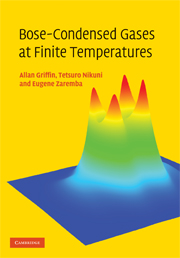Book contents
- Frontmatter
- Contents
- Preface
- 1 Overview and introduction
- 2 Condensate dynamics at T = 0
- 3 Coupled equations for the condensate and thermal cloud
- 4 Green's functions and self-energy approximations
- 5 The Beliaev and the time-dependent HFB approximations
- 6 Kadanoff–Baym derivation of the ZNG equations
- 7 Kinetic equation for Bogoliubov thermal excitations
- 8 Static thermal cloud approximation
- 9 Vortices and vortex lattices at finite temperatures
- 10 Dynamics at finite temperatures using the moment method
- 11 Numerical simulation of the ZNG equations
- 12 Simulation of collective modes at finite temperature
- 13 Landau damping in trapped Bose-condensed gases
- 14 Landau's theory of superfluidity
- 15 Two-fluid hydrodynamics in a dilute Bose gas
- 16 Variational formulation of the Landau two-fluid equations
- 17 The Landau–Khalatnikov two-fluid equations
- 18 Transport coefficients and relaxation times
- 19 General theory of damping of hydrodynamic modes
- Appendix A Monte Carlo calculation of collision rates
- Appendix B Evaluation of transport coefficients: technical details
- Appendix C Frequency-dependent transport coefficients
- Appendix D Derivation of hydrodynamic damping formula
- References
- Index
17 - The Landau–Khalatnikov two-fluid equations
Published online by Cambridge University Press: 06 October 2009
- Frontmatter
- Contents
- Preface
- 1 Overview and introduction
- 2 Condensate dynamics at T = 0
- 3 Coupled equations for the condensate and thermal cloud
- 4 Green's functions and self-energy approximations
- 5 The Beliaev and the time-dependent HFB approximations
- 6 Kadanoff–Baym derivation of the ZNG equations
- 7 Kinetic equation for Bogoliubov thermal excitations
- 8 Static thermal cloud approximation
- 9 Vortices and vortex lattices at finite temperatures
- 10 Dynamics at finite temperatures using the moment method
- 11 Numerical simulation of the ZNG equations
- 12 Simulation of collective modes at finite temperature
- 13 Landau damping in trapped Bose-condensed gases
- 14 Landau's theory of superfluidity
- 15 Two-fluid hydrodynamics in a dilute Bose gas
- 16 Variational formulation of the Landau two-fluid equations
- 17 The Landau–Khalatnikov two-fluid equations
- 18 Transport coefficients and relaxation times
- 19 General theory of damping of hydrodynamic modes
- Appendix A Monte Carlo calculation of collision rates
- Appendix B Evaluation of transport coefficients: technical details
- Appendix C Frequency-dependent transport coefficients
- Appendix D Derivation of hydrodynamic damping formula
- References
- Index
Summary
In Chapter 15, we showed that in the limit of short collision times the coupled equations of motion for the condensate and noncondensate atoms lead to Landau's non-dissipative two-fluid hydrodynamics. However the approach used in Chapter 15 was not based on a small expansion parameter, in contrast with the more systematic Chapman–Enskog procedure used to derive hydrodynamic damping in the kinetic theory of classical gases. In the present chapter, we generalize the procedure of Chapter 15 to trapped Bose-condensed gases, in order to derive two-fluid hydrodynamic equations that include dissipation due to transport processes. We solve the kinetic equation by expanding the nonequilibrium single-particle distribution function f(p, r, t) around the distribution function f(0)(p, r, t) that describes complete local equilibrium between the condensate and the noncondensate components. All hydrodynamic damping effects are included by taking into account deviations from the local equilibrium distribution function f(0). Our discussion for a trapped Bose gas is a natural extension of the pioneering work of Kirkpatrick and Dorfman (1983, 1985a) for a uniform Bose-condensed gas. This chapter is mainly based on their work as well as on Nikuni and Griffin (2001a,b).
We will prove that, with appropriate definitions of various thermodynamic variables, our two-fluid hydrodynamic equations including damping have precisely the structure of those first derived by Landau and Khalatnikov for superfluid He. In particular, the damping associated with the collisional exchange of atoms between the condensate and noncondensate components, which is discussed at length in Chapter 15, is now expressed in terms of frequency-dependent second viscosity coefficients. This special type of damping is a characteristic signature of a dilute Bose superfluid and exists in addition to the hydrodynamic damping associated with the shear viscosity and thermal conductivity of the normal fluid.
- Type
- Chapter
- Information
- Bose-Condensed Gases at Finite Temperatures , pp. 371 - 394Publisher: Cambridge University PressPrint publication year: 2009



